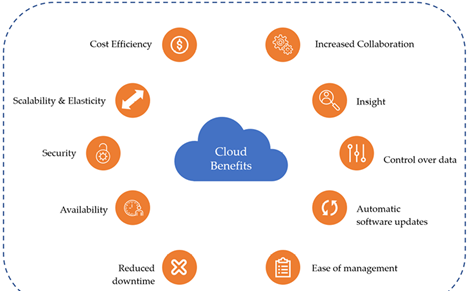Advantages of Cloud – Basics of Google Cloud Platform
There are various advantages of cloud as shown in Figure 1.1, and mentioned as follows:

Figure 1.1: Advantages of Cloud platform
- Cost efficiency: In terms of IT infrastructure management, cloud computing is undoubtedly the most cost-effective option. It is incredibly affordable for organizations of any size to transition from on-premises hardware to the cloud thanks to a variety of pay-as-you-go and other scalable choices. Using cloud resources instead of purchasing costly server equipment and PCs that need a lot of time to set up and maintain, such as long hours of setup and maintenance. Cloud also helps in reduced spending on compute, storage, network, operational and upgrade expenses.
- Scalability and elasticity: Overall, cloud hosting is more flexible than hosting on a local machine. You do not have to undertake a costly (and time-consuming) upgrade to your IT infrastructure if you need more bandwidth. This increased degree of latitude and adaptability may have a major impact on productivity.
Elasticity is only employed for a short amount of time to deal with rapid shifts in workload. This is a short-term strategy used to meet spikes in demand, whether they are unanticipated or seasonal. The static increase in workload is met through scalability. To cope with an anticipated rise in demand, a long-term approach to scalability is used.
- Security: Cloud platform provides a multitude of cutting-edge security measures, which ensure the safe storage and management of any data. Granular permissions and access control using federated roles are two examples of features that may help limit access to sensitive data to just those workers who have a legitimate need for it. This helps reduce the attack surface that is available to hostile actors. Authentication, access control, and encryption are some of the fundamental safeguards that providers of cloud storage put in place to secure their platforms and the data that is processed on those platforms. After that, users can implement additional security measures of their own, in addition to these precautions, to further strengthen cloud data protection and restrict access to sensitive information stored in the cloud.
- Availability: The vast majority of cloud service providers are quite dependable in terms of the provision of their services; in fact, the vast majority of them maintain an uptime of 99.9 percent. Moving to the cloud should be done with the intention of achieving high availability. The goal is to make your company’s goods, services, and tools accessible to your clients and workers at any time of day and from any location in the world using any device that can connect to the internet.
- Reduced downtime: Cloud based solutions provide the ability to operate critical systems and data directly from the cloud or to restore them to any location. During a catastrophic event involving information technology, they make it easier for you to get these systems back online, reducing the amount of manual work required by conventional recovery techniques.
- Increased Collaboration: Developers, QA, operations, security, and product architects are all exposed to the same infrastructure and may work concurrently without tripping on one another’s toes in cloud settings. To minimize disputes and misunderstanding, cloud roles and permissions provide more visibility and monitoring of who performed what and when. Different cloud environments, such as staging, QA, demo, and pre-production, may be created for specialized reasons. The cloud makes transparent collaboration simpler and promotes it.
- Insight: A bird’s-eye perspective of your data is also provided through the integrated cloud analytics that are offered by cloud platforms. When your data is kept in the cloud, it is much simpler to put in place, monitoring systems and create individualized reports for doing information analysis throughout the whole organization. You will be able to improve efficiency and construct action plans based on these insights, which will allow your organization to fulfil its objectives.
- Control over data: Cloud provides you total visibility and control over your data. You have complete control over which users are granted access to which levels of specified data. This not only gives you control, but also helps simplify work by ensuring that staff members are aware of the tasks they have been allocated. Additionally, it will make working together much simpler. Because several users may make edits to the same copy of the text at the same time, there is no need that multiple copies of the document be distributed to the public.
- Automatic software updates: There is nothing more cumbersome than being required to wait for the installation of system upgrades, especially for those who already have a lot on their plates. Applications that are hosted in the cloud instantly refresh and update themselves, eliminating the need for an IT personnel to carry out manual updates for the whole organization. This saves critical time and money that would have been spent on consulting from other sources.
- Ease of managing: The use of cloud can streamline and improve IT maintenance and management capabilities through the use of agreements supported by SLA, centralized resource administration, and managed infrastructure. Users can take advantage of a simple user interface without having to worry about installing anything. In addition, users are provided with management, maintenance, and delivery of the IT services.